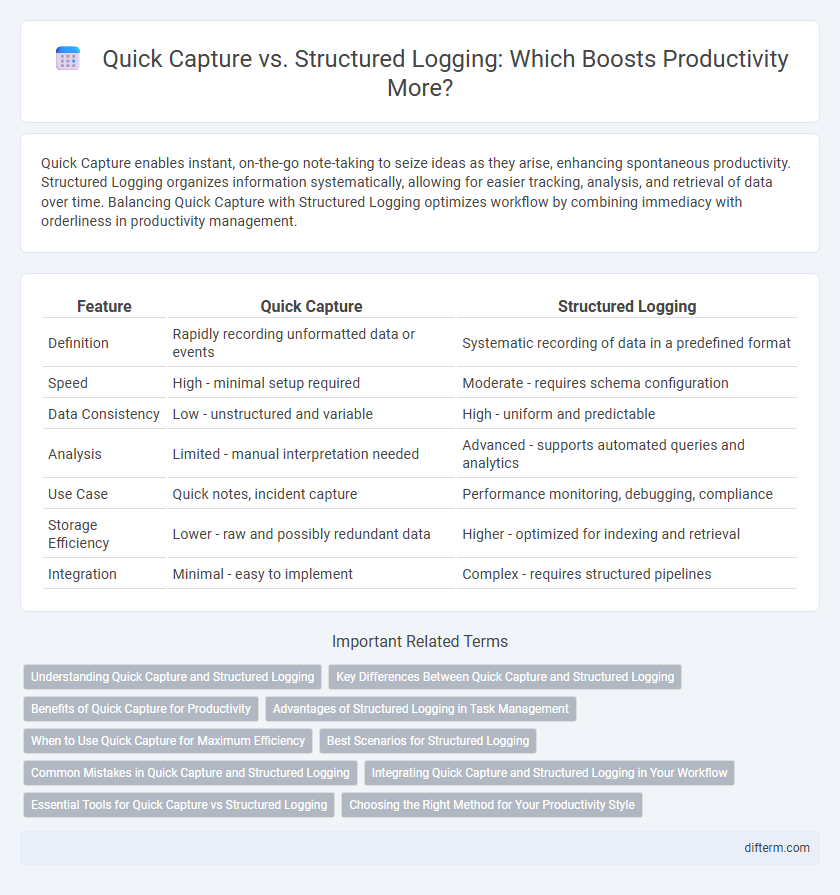Quick Capture enables instant, on-the-go note-taking to seize ideas as they arise, enhancing spontaneous productivity. Structured Logging organizes information systematically, allowing for easier tracking, analysis, and retrieval of data over time. Balancing Quick Capture with Structured Logging optimizes workflow by combining immediacy with orderliness in productivity management.
Table of Comparison
| Feature | Quick Capture | Structured Logging |
|---|---|---|
| Definition | Rapidly recording unformatted data or events | Systematic recording of data in a predefined format |
| Speed | High - minimal setup required | Moderate - requires schema configuration |
| Data Consistency | Low - unstructured and variable | High - uniform and predictable |
| Analysis | Limited - manual interpretation needed | Advanced - supports automated queries and analytics |
| Use Case | Quick notes, incident capture | Performance monitoring, debugging, compliance |
| Storage Efficiency | Lower - raw and possibly redundant data | Higher - optimized for indexing and retrieval |
| Integration | Minimal - easy to implement | Complex - requires structured pipelines |
Understanding Quick Capture and Structured Logging
Quick Capture enables rapid input of ideas or data with minimal formatting, ideal for spontaneous note-taking and immediate productivity boosts. Structured Logging organizes information into predefined categories, enhancing searchability and analysis, which supports long-term project management and detailed documentation. Combining these methods optimizes workflow by balancing speed and organization in productivity systems.
Key Differences Between Quick Capture and Structured Logging
Quick Capture prioritizes speed and simplicity, allowing users to rapidly record unstructured notes or data with minimal setup, making it ideal for spontaneous input. Structured Logging organizes information into predefined formats with consistent schema, enabling detailed analysis and easier retrieval of specific data points. Key differences include Quick Capture's focus on immediacy and flexibility versus Structured Logging's emphasis on data uniformity and enhanced searchability for productivity optimization.
Benefits of Quick Capture for Productivity
Quick Capture enhances productivity by enabling immediate recording of ideas and tasks without interrupting workflow, reducing the risk of forgetting critical information. It supports rapid decision-making and continuous thought flow, minimizing cognitive load compared to structured logging's more time-intensive format. This instant input capability leads to faster task initiation and seamless progress tracking, boosting overall efficiency.
Advantages of Structured Logging in Task Management
Structured logging enhances task management by enabling precise filtering and searching of log data, which accelerates issue identification and resolution. Its standardized format supports integration with various analytics tools, improving monitoring and performance tracking of workflows. This systematic approach reduces errors and increases transparency, fostering better team collaboration and productivity.
When to Use Quick Capture for Maximum Efficiency
Quick Capture is ideal for situations requiring immediate note-taking or rapid idea collection, enabling users to record thoughts without interrupting workflow. It maximizes efficiency during brainstorming sessions, quick meetings, or capturing fleeting insights before they are forgotten. For tasks demanding detailed analysis or long-term tracking, structured logging provides better organization and retrieval.
Best Scenarios for Structured Logging
Structured logging excels in scenarios requiring detailed insights and traceability, such as complex applications where debugging and performance monitoring are critical. It organizes log data into consistent formats, enabling efficient querying, filtering, and correlation across distributed systems. This method is particularly effective for large-scale environments needing automated alerting and proactive issue resolution.
Common Mistakes in Quick Capture and Structured Logging
Common mistakes in quick capture include capturing incomplete or unstructured information, leading to confusion and inefficiency during review. Structured logging errors often involve improper formatting or inconsistent data entry, which hinder accurate data retrieval and analysis. Both methods require discipline to maintain clarity and usefulness in productivity workflows.
Integrating Quick Capture and Structured Logging in Your Workflow
Integrating Quick Capture and Structured Logging in your workflow enhances productivity by enabling rapid data entry alongside detailed, organized information management. Quick Capture allows for immediate note-taking and task tracking, while Structured Logging ensures consistent, easily analyzable records for performance review and process improvement. Combining these methods streamlines communication and supports data-driven decision-making across teams.
Essential Tools for Quick Capture vs Structured Logging
Essential tools for quick capture include note-taking apps like Evernote and voice recording software such as Otter.ai, designed for rapid information input without interrupting workflow. Structured logging relies on specialized platforms like Logstash and Splunk that organize, analyze, and visualize data systematically to enhance project tracking and debugging. These tools enable productivity by streamlining data capture methods suited to either spontaneous ideas or detailed, categorized records.
Choosing the Right Method for Your Productivity Style
Quick Capture enables rapid recording of ideas and tasks, ideal for those who thrive on spontaneous productivity and minimal disruption. Structured Logging offers detailed, organized documentation suited for individuals who prefer systematic tracking and comprehensive analysis of their workflow. Selecting the appropriate method depends on your preferred balance between speed and structure to maximize efficiency and maintain focus throughout your workday.
Quick Capture vs Structured Logging Infographic

 difterm.com
difterm.com